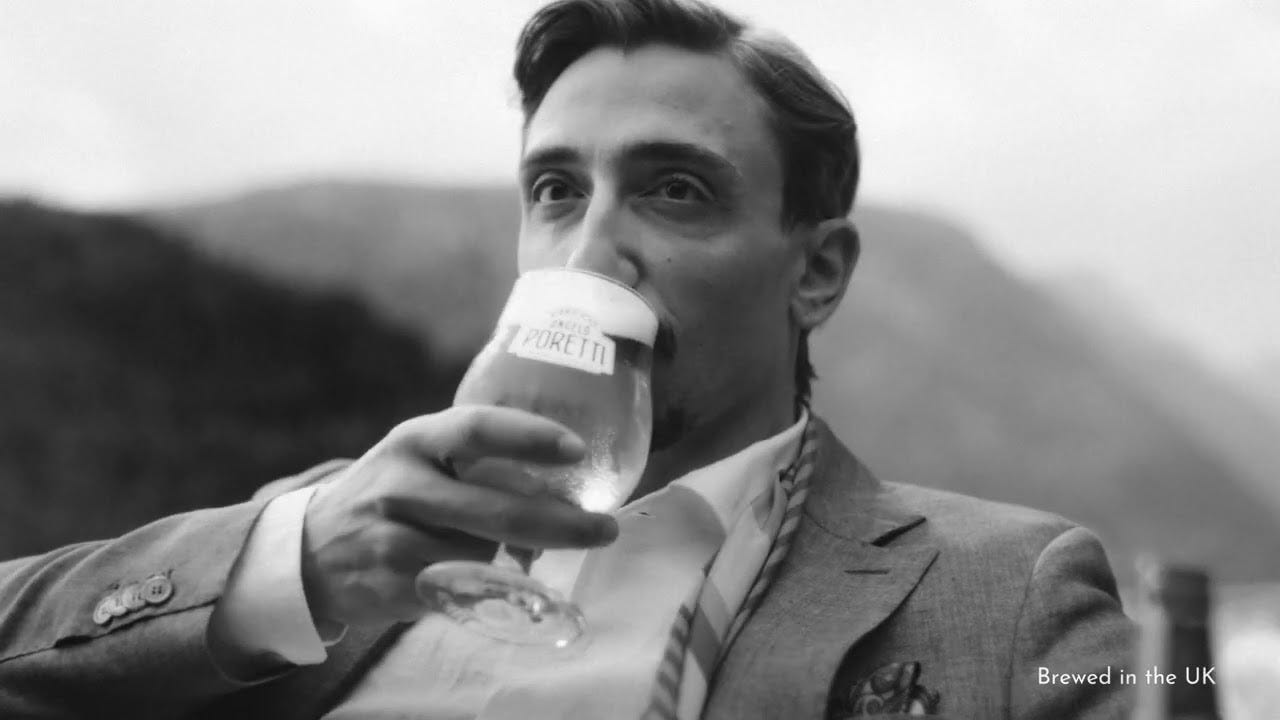Bi-Weekly-ish Newsletter #75 w/ Nonsensical Italian Hits 🎶🍺, Jack White's Coke Secret 🥤🎸, Music Lawsuit Tsunami ⚖️💰, Kid vs. Rothko Drama 🖼️👶, and Hardcore Krishna Journey 🎵🙏
Dear reader,
Back with another edition where I balance music, art and all sorts of legal drama while trying to make sense of our increasingly bizarre cultural landscape.
This time, a surreal Italian beer campaign with gibberish lyrics, Jack White's one-time Coca-Cola collaboration, the wave of music copyright lawsuits hitting major brands, a child's expensive encounter with a Rothko masterpiece and my personal journey from hardcore punk to not-completely-spitting on alternative spiritual paths.
As always, expect strong opinions dozed in nihilism, industry insights also dozed in nihilism and some Ringo soft selling.
Enjoy and thanks for reading.
1. Nonsensical '70s Italian Hit Makes Beer Bizarre
When Gibberish Lyrics Create the Perfect Vibe
It's all vibes baby! The new Poretti beer's stylish "Welcome to the Lake" campaign features Adriano Celentano's 1972 hit proto‑rap experiment "Prisencolinensinainciusol", as friends embark on an attitude-packed boat trip across Italy's northern lakes. The black-and-white spot invites drinkers to "ditch the usual and embrace the unexpected", supposedly just like Angelo Poretti did with his unorthodox brewing techniques back in 1877.
What makes the track choice perfect is its fascinating backstory. "Prisencolinensinainciusol" was Celentano's deliberate linguistic experiment, he composed complete gibberish lyrics designed to sound like American English to Italian ears. Despite (or because of) nonsense lyrics like "Uis de seim cius nau op...," the song became a hit across Europe in the 70s (ah the 70s!), proving that rhythm and melody could communicate feeling even without comprehensible words.
I love it when advertising embraces weirdness, as per all the films I've been sharing here lately. Watch the commercial below.
2. Jack White's One-Time Coke Wonder
When Rock Credibility Met Corporate America for 100 Seconds
Shifting from beer to cola, but staying with the weird and wonderful, here's a campaign that popped up through the almighty algorithm called Instagram; the long-forgotten Coca-Cola x Jack White collaboration from 2006.
I'm sure most of you haven't seen it since it was intentionally aired just once at 1:55 a.m. on UK's Channel 4 per White's contractual demands. The commercial "What Goes Around Comes Around," directed by Japanese pop artist Nagi Noda, follows a red-haired woman moving through frozen scenes that come alive in sequence, creating a chain reaction of kindness and positivity and could have been a White Stripes video for all we know (and care).
What makes this collaboration particularly fascinating is the contradiction it represents: Jack White, the garage rock purist, creating his first-ever commercial jingle "Love Is The Truth" for corporate giant Coca-Cola. This was the same artist who once claimed he'd only license a song called "Sugar Never Tasted So Good" to artificial sweetener companies, now writing for a drink with 39 grams of sugar. Despite this apparent contradiction, White viewed the project as "an opportunity to record an inspirational song that could reach a worldwide audience."
The 100-second spot won a Bronze Lion at Cannes in 2006 despite its single showing. Watch this piece of art/advertising history below, a perfect example of how commercials can transcend their commercial purpose and a testament to why according to some, advertising is the greatest art form of the twentieth century.
3. The Social Media Music Lawsuit Tsunami
When Cookie Companies and Shoe Retailers Get Hit With $50M+ Claims
I've been mentioning this to everyone who wants to listen (and probably the reason I don't get invited anywhere anymore, but 99% of companies are subject to lawsuits for using music on social media without proper clearances.
The latest perpetrators of this social-sync piracy (still looking for a catchier name, suggestions welcome) are cookie giant Crumbl and shoe retailer DSW. Warner Music Group has sued both companies in separate cases, alleging massive-scale copyright infringement through unauthorized use of protected recordings in TikTok and Instagram videos. Crumbl is facing allegations of using 159 tracks from artists like Taylor Swift and Beyoncé, while DSW is accused of misappropriating over 200 works, including Cardi B's "Up" and Fleetwood Mac's "Dreams." With statutory damages reaching up to $150,000 per infringement, Crumbl could be liable for a potential bill of $23.85 million, whereas DSW may owe over $30 million. This comes at a time when Crumbl is exploring a potential sale valued at $2 billion.
The most perplexing aspect of these cases is the stark contrast between the sophisticated social media strategies of these companies and their careless approach to music licensing. Crumbl co-founder Jason McGowan stated to The Wall Street Journal that their strategy focused on social media, supported by a team of over 30 people. Meanwhile, DSW, with decades of experience in proper music licensing, mistakenly thought the rules didn't apply to their Instagram posts. Both companies relied on influencers who received "perks and rewards" for creating promotional content with copyrighted music, seemingly hoping the legal responsibility would fall on these smaller creators. Even after receiving a cease-and-desist letter in August 2023, Crumbl continued to post infringing content, challenging WMG to take legal action against them.
These lawsuits reflect a growing trend of music companies targeting brands rather than platforms. UMG has sued Chili's, Sony settled with Marriott Hotels, and has also sued USC, in addition to multiple publishers suing 14 NBA teams. Bang Energy lost similar cases against Universal and Sony in 2022.
The bigger question is why global PROs aren't actively working with social platforms to solve this issue that's affecting virtually every brand with a social presence. What we need is microlicensing at scale an efficient way for businesses to legally use music in their social content without facing eight-figure lawsuits.
Until then, every company posting music-backed content is essentially laying musical chairs with million-dollar lawsuits instead of chairs. The real winner? The lawyers, as always. Find the full deposition here.
This is an ad...
While major labels sue companies for millions over unauthorized music use in social media, Ringo offers a better solution. Our platform provides instant pricing indications for music supervisors and brands, removing the operational friction that makes proper licensing seem so damn daunting. With Ringo, you can:
Upload Spotify playlists of tracks you're considering
Specify usage terms (territory, media, duration)
Get algorithmic pricing signals immediately
Avoid becoming the next multimillion-dollar lawsuit headline
We just shipped Beta 003, with over 150 active users using it. Visit www.thisisringo.com to join them and discover how music licensing can be safe, simple and stress-free. Your legal department will thank you.
4. Kid vs. Rothko: A Multimillion-Dollar Scratch
When Toddlers Take on Abstract Expressionism
Here's an interesting story that flew under the radar thanks to some clever timing. Press-released on King's Night (the day before King's Day when everyone in the Netherlands is too drunk to follow the news, and the day after, too hungover), a child managed to damage a Mark Rothko painting valued at approximately €52 million at the Depot Boijmans Van Beuningen in Rotterdam.
According to CNN, the massive abstract painting "Grey, Orange on Maroon, No. 8" from 1960 sustained "superficial damage" when a child "touched the painting" - museum-speak for "scratched the hell out of the unvarnished lower portion of a priceless masterpiece." The painting, measuring, has now been removed from display while conservators from the Netherlands and abroad determine how to repair the damage.
This incident raises a host of questions that have been swirling in my mind since reading this news. How does something like this even happen? The museum has remained tight-lipped about exactly how the child accessed the painting long enough to damage it especially curious since I visited the same museum last week and was practically yelled at for stepping one millimeter too close to a different artwork. Where was security? Where were the parents? And speaking of parents, imagine that sinking feeling when you realize your offspring just damaged something worth more than your lifetime earnings. Are they responsible for the costs? Is the museum insured for "child meets Rothko" scenarios?
The museum has declined to comment on the painting's exact value or repair costs, simply stating that "we expect the work will be able to be shown again in the future", perhaps the art world's equivalent of "the surgery was successful but the patient remains in critical condition."
5. Spiritual Edge: From NYHC to Hare Krishna
When Punk Rock Meets Spiritual Enlightenment
I went to see a band called Shelter two weeks ago. For context, I grew up in the 90s immersed in hardcore punk and quickly gravitated toward straight edge, no drinking, no drugs, no fucking around. A conscious rejection of punk's more destructive, nihilistic "no future" ethos that never resonated with me. Instead, I found myself drawn to New York hardcore bands like Judge, Gorilla Biscuits and Youth of Today, all from the same era and seemingly all friends, preaching positivity amid the chaos. Two years ago, Youth of Today played a reunion show I happened to catch while visiting Berlin, and I loved every minute of their raw energy and conviction. Some things never change.
Youth of Today's singer Ray Cappo was (and remains) quite the character. For him back in the late 80s/early 90s, abstaining from substances wasn't enough as he sought a more spiritual path and became a Hare Krishna devotee, eventually forming Shelter. The band achieved mainstream success in the 90s when major labels were desperately searching for the next Nirvana and somehow saw potential in these spiritually-driven hardcore kids. Shelter had many fans and influenced several of my friends who actually became Krishna devotees themselves, one still lives in a monastery. When another friend texted asking if I wanted to join him at a Shelter show, my first instinct was the default "no." But I quickly realized that made no sense and went along. My 16-year-old programming kicked in, and I found myself remembering every lyric, every breakdown.
What strikes me most isn't the Krishna path itself, which honestly isn't for me (no sex and no garlic? Come on, those are two of life's greatest pleasures) but how this music that once seemed so short-lived has had such lasting impact. While I won't be giving up garlic bread or moving to a monastery anytime soon (ever), there's something strangely relevant about Cappo's rejection of mindless consumption in our increasingly AI-driven, algorithm-optimized world. With a 12-hour round-trip drive to Hamburg ahead of me, I listened to "From Punk To Monk," Cappo's book where he recounts hanging with bands I idolized while exploring his spiritual path in India. Watch Cappo's book here and see Shelter live at Dynamo below and decide for yourself if hardcore ethics might offer some unexpected wisdom for our chaotic times.
Thanks for reading and Hare Krishna to you and yours.
I'm visiting Hamburg again in two weeks for the ADC, drop me a line for a coffee of sorts.
Thsjuss!






